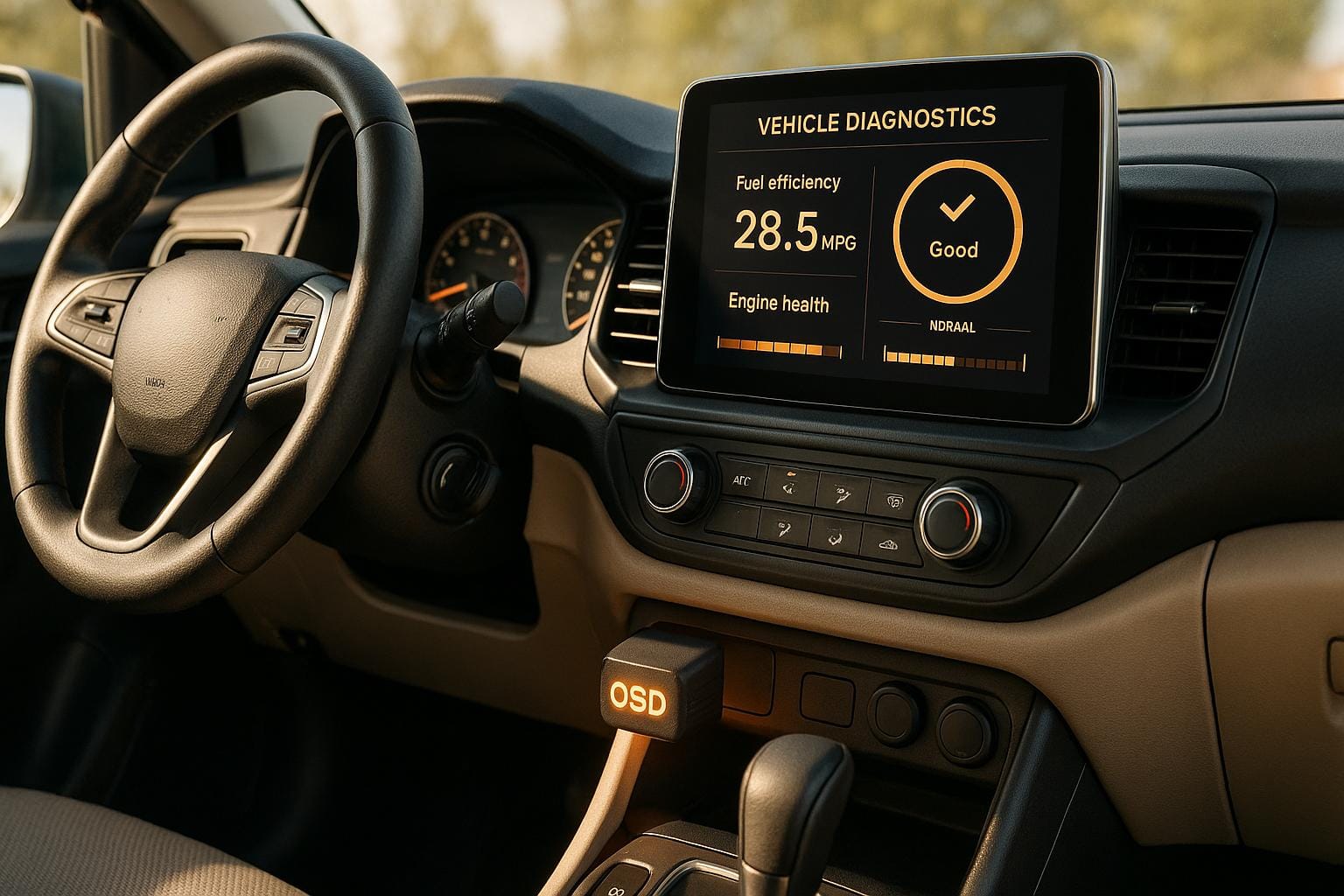AI anomaly detection is transforming fleet management by helping businesses prevent breakdowns, improve security, and increase efficiency. Here's how it works and why it matters:
- What It Does: AI analyses vehicle data to detect unusual patterns, flagging potential issues like mechanical failures, unsafe driving, or theft risks.
- How It Works: Machine learning models monitor real-time data (e.g., engine performance, driver behaviour), identifying anomalies that could indicate problems.
- Key Benefits:
- Predictive Maintenance: Prevent breakdowns, saving up to 30% on repair costs.
- Enhanced Security: Recover stolen vehicles faster, with recovery rates as high as 91%.
- Improved Efficiency: Reduce downtime by 35%, optimise fuel use, and cut delivery times.
Quick Comparison of AI Methods
| Method | Strengths | Limitations | Best For |
|---|---|---|---|
| Supervised | High accuracy for known issues | Needs labelled data; misses new issues | Recurring maintenance problems |
| Unsupervised | Detects unknown anomalies | Higher false positives | Novel threats, exploratory tasks |
| Semi-Supervised | Balances automation with human input | Moderately complex to implement | Complex operations |
| Deep Learning | Handles complex data patterns | High computing power required | Large, intricate fleets |
| Statistical | Simple and cost-effective | Prone to false positives | Small fleets, simpler needs |
AI anomaly detection is critical for modern fleets, offering cost savings, better security, and smoother operations. Whether it's predictive maintenance or theft prevention, adopting the right AI tools can significantly improve performance.
Real-Life Examples of AI Sensor Fusion Predictive Maintenance
AI Methods for Fleet Anomaly Detection
Building on the advantages of fleet monitoring, advanced machine learning techniques now allow fleet managers to detect anomalies with impressive accuracy. These AI-driven methods can identify potential issues early, preventing minor concerns from escalating into costly problems. From traditional statistical models to cutting-edge deep learning approaches, each method is designed to tackle specific challenges in fleet data. Let’s explore these techniques and their practical use in fleet operations.
Machine Learning Models for Detecting Anomalies
Deep learning techniques have become a cornerstone of anomaly detection. Long Short-Term Memory (LSTM) networks are particularly effective with time-series data, using specialised gates to retain critical information while filtering out irrelevant noise. Autoencoders, on the other hand, work by compressing and reconstructing data; any significant reconstruction error signals an anomaly. When combined, LSTM-autoencoder frameworks deliver exceptional results. For instance, a recent study reported a 97% accuracy rate, using sensors to track vibrations in multiple directions - a setup that mirrors modern fleet telematics systems monitoring vehicle performance.
Traditional machine learning methods are also valuable tools in anomaly detection. Techniques like Local Outlier Factor (LOF) and K-Nearest Neighbours (kNN) can identify vehicles behaving outside expected norms. Other approaches, such as Support Vector Machines (SVM), DBSCAN clustering, and Bayesian networks, offer alternative ways to distinguish normal behaviour from anomalies. The choice of method often depends on the available data and the specific needs of the fleet.
| Anomaly Type | Description | Fleet Application Example |
|---|---|---|
| Outliers | Isolated, irregular anomalies | Sudden engine temperature spikes, unusual fuel consumption |
| Change in Events | Abrupt deviations from past behaviour | Sudden shifts in driver braking patterns |
| Drifts | Gradual, long-term changes | A slow decline in vehicle efficiency over time |
Model Training and Performance Measurement
Training AI models for anomaly detection starts with high-quality data. This includes sensor readings, GPS data, driver behaviour logs, and maintenance records, all of which help establish a baseline for normal operations. To measure model effectiveness, metrics like accuracy, precision, recall, and F1-score are used. Confusion matrices further break down results into true positives, false negatives, false positives, and true negatives.
Studies have shown that LSTM-autoencoders outperform standard autoencoders, achieving lower loss values and mean squared error anomalies, although they typically require more training time. As one expert from Monolith explains:
"When it comes to anomaly detection, the goal isn't just accuracy - it's impact. A model that performs well on abstract metrics but fails in the real world isn't useful. That's why evaluation should mirror reality." - Monolith
Real-world testing is essential to validate laboratory findings. While reconstruction error methods focus on modelling normal patterns, classification approaches provide a broader evaluation of the entire detection process.
This approach aligns well with the needs of UK fleets. By integrating these AI models with robust telematics systems - such as those offered by GRS Fleet Telematics - operators can continuously monitor fleet conditions and adapt to factors like seasonal changes, route modifications, driver shifts, and vehicle ageing. Regular retraining and performance monitoring ensure these systems remain effective in the dynamic environment of UK fleet management.
Case Studies: AI Anomaly Detection in Action
Building on the AI methods explored earlier, these examples illustrate how anomaly detection is transforming maintenance, security, and operational efficiency across various fleet operations.
Predictive Maintenance and Preventing Breakdowns
Shifting from reactive to predictive maintenance has been a game-changer for fleet management. AI-driven systems constantly monitor key metrics like engine performance, fuel usage, tyre pressure, and temperature to spot irregularities before they turn into costly problems.
For instance, one bus fleet managed to cut downtime by 35% and save £200,000 annually through predictive maintenance powered by AI. Similarly, machine learning in transport systems reduced unscheduled maintenance by 40%, resulting in £300,000 in yearly savings. Across industries, predictive maintenance has been shown to lower downtime by 30–50% and trim maintenance costs by 15–30%. Considering that unplanned downtime costs industries an estimated £50 billion annually, these savings are a big win for fleet operators.
Electric vehicle fleets have also reaped rewards from AI integration. One system achieved an impressive 92% accuracy in predicting maintenance needs, leading to £150,000 in annual cost savings. This was achieved by monitoring battery health, charging habits, and motor efficiency with remarkable precision.
Vehicle Security and Theft Prevention
AI doesn’t just help with maintenance - it also strengthens vehicle security. Modern systems use GPS tracking, AI-powered cameras, and real-time monitoring to create robust security networks.
Take the case of a landscaping company that experienced a theft attempt. When a trailer was disconnected, the AI system flagged unusual movement and sent geofence breach alerts. Thanks to these alerts, law enforcement recovered the trailer within hours and identified the suspect using AI-enhanced camera footage.
GRS Fleet Telematics has achieved a 91% recovery rate for stolen vehicles by combining dual-tracker technology with 24/7 monitoring. With cargo theft rising by 1,500% since 2021 and costing the industry an estimated £35 billion annually, such systems are indispensable. One trucking company, for example, recovered stolen vehicles within hours, a stark improvement compared to the eight-month delay they experienced with a previous provider.
"Thanks to the Motive Vehicle Gateway, I started tracking the van while I was on the phone with the San Jose Police Department. We were able to track it and recover it." – Jon Fontaine, Corporate Fleet Manager
AI-powered dash cameras have also proven their worth, helping companies recover millions of pounds worth of stolen equipment. Clear video evidence from these cameras has supported successful prosecutions, further enhancing their value.
Fleet Efficiency and Route Planning
AI anomaly detection is also making fleets more efficient by analysing driver behaviour, fuel consumption, and route patterns to uncover areas for improvement. Real-time GPS tracking enables dynamic route adjustments, while AI algorithms use historical data to design more efficient routes, cutting both fuel use and delivery times.
Driver behaviour monitoring takes this further by identifying issues like harsh braking, rapid acceleration, or speeding. These insights allow fleet managers to implement driver training programmes that improve safety and reduce vehicle wear.
Fuel efficiency tracking is another area where AI shines. By identifying vehicles that consume more fuel than expected, fleet operators can target specific vehicles for maintenance or provide coaching to drivers, resulting in tangible cost savings.
GRS Fleet Telematics offers these advanced monitoring tools at an accessible price, starting at just £7.99 per vehicle per month. These examples highlight how AI anomaly detection is delivering real, measurable benefits for fleets of all sizes, enhancing their overall management and performance.
Comparing AI Anomaly Detection Methods
Selecting the right AI method for fleet anomaly detection hinges on your specific goals, the data you have available, and the operational demands of your fleet. Each method comes with its own strengths and challenges, which fleet managers need to weigh carefully before making a decision. Here's a closer look at these methods to help guide your choice.
Supervised anomaly detection is ideal when you have well-labelled data that clearly distinguishes between normal operations and known issues. This method relies on detailed labelling to identify events that signify genuine anomalies versus regular fleet behaviour. While this requires a significant upfront effort, it delivers high accuracy in spotting recurring problems. For instance, supervised models are particularly effective in identifying maintenance issues like engine failures, which often follow specific patterns in temperature or vibration data. This is because fleet managers often have extensive historical data to differentiate normal behaviour from faults.
However, supervised systems depend heavily on historical examples. If a fleet encounters a completely new type of problem that wasn’t part of the training data, these systems may fail to detect it. This makes them great for recurring or well-documented issues but less effective for uncovering entirely new problems.
Unsupervised anomaly detection, on the other hand, doesn’t rely on pre-labelled data. Instead, it establishes baseline patterns for metrics like vehicle performance and driver behaviour, flagging anything that deviates significantly from these norms. This makes it a valuable tool for identifying new operational inefficiencies or threats that weren’t present during initial data collection.
The downside? Unsupervised systems can struggle with reliability, often generating a high number of false positives. For example, a system with a false positive rate of one in 1,000 could trigger 100 alerts for an event that occurs only once in a million instances, with just one of those alerts being accurate.
Semi-supervised (hybrid) methods aim to combine the best of both worlds. These systems use unsupervised learning to identify patterns but incorporate human oversight to refine the process. This approach seeks to reduce false positives while still being capable of spotting previously unseen issues.
AI Techniques Comparison Table
| Technique | Key Benefits | Limitations | Typical Use Cases |
|---|---|---|---|
| Supervised Detection | High accuracy for known anomaly types; reliable predictions with quality labels; easier validation | Requires extensive data labelling; cannot detect new issues; significant upfront effort | Recurring maintenance issues; known security threats; compliance monitoring |
| Unsupervised Detection | Identifies new and unknown issues; minimal manual data preparation; adapts to changing patterns | Higher false positive rates; risk of learning incorrect patterns; less reliable without validation | Novel threat detection; exploratory analysis; systems with limited historical data |
| Semi-Supervised (Hybrid) | Balances automation with human input; more precise predictions; combines strengths of both approaches | Moderate complexity to implement; requires ongoing human oversight; some manual effort needed | Complex fleet operations; mixed threat environments; systems needing high reliability |
Deep learning methods are the most advanced option, excelling at handling complex, sequential data patterns. These systems offer exceptional accuracy but demand significant computing power and expertise. They are best suited for large fleets with intricate operational patterns and the necessary technical resources.
Statistical methods, by contrast, are simpler to implement. They’re easy to interpret and require less computational power, making them a practical choice for smaller fleets with straightforward operations. However, they are sensitive to data assumptions and prone to false positives in datasets with unusual distributions.
Your choice of method will depend on factors like fleet size, operational complexity, data quality, and integration needs. For example, machine learning-based fraud detection models have been shown to reduce financial losses by up to 52% compared to traditional rule-based systems, making them a compelling option for larger fleets. Smaller fleets, however, may find statistical methods more suitable and cost-effective. Keep in mind that machine learning systems require high-quality data for training; inconsistent data can lead to inaccurate results. Additionally, integrating AI solutions into existing fleet management systems can be challenging, requiring careful planning to ensure scalability and compatibility. This comparison highlights the importance of tailoring your approach to suit the unique demands of your fleet.
Summary and Future Developments
AI-driven anomaly detection is reshaping fleet management by delivering impressive results in key areas. For instance, Ernst Concrete achieved a 2,000% ROI and £5.2 million in estimated savings in just 13 months, while also reducing distracted driving incidents by 83%. These successes illustrate how AI shifts fleet operations from reactive problem-solving to proactive prevention, paving the way for advancements in predictive maintenance, vehicle security, and operational efficiency.
Predictive Maintenance: Staying Ahead of Failures
Predictive maintenance is a game-changer for fleet management. AI algorithms can now anticipate maintenance needs before equipment fails, helping to minimise downtime, extend vehicle lifespan, and cut repair costs. By tracking deviations such as rising engine temperatures or unusual brake wear, these systems raise alerts early, enabling timely interventions. Companies using predictive maintenance report significant improvements in reliability and cost efficiency.
Vehicle Security: Fighting Theft with AI
AI has also transformed vehicle security by detecting unusual patterns in real time, making it an effective tool against theft. This technology offers fleets operating across multiple locations an added layer of protection, as seen in earlier case studies. It’s a vital development for safeguarding valuable assets.
Operational Efficiency: Smarter, Faster, and Greener
AI contributes to operational efficiency by enabling dynamic route optimisation. By factoring in traffic, weather, and other variables, fleets can achieve faster deliveries, lower fuel consumption, and better compliance with regulations. These improvements not only save time and money but also enhance overall fleet performance.
The Rise of Generative AI in Fleet Operations
Generative AI spending surged by 500% last year, reaching £11.1 billion, with 71% of physical operations leaders now incorporating it into their daily workflows. Fleets using advanced AI systems report a reduction in safety incidents of over 90% within six months, while AI-powered vision systems have cut at-fault accidents by up to 91%.
Emerging Trends: Collaboration and Continuous Learning
AI continues to evolve with trends like collaborative learning and continuous model improvement. Collaborative learning allows decentralised model training, ensuring data privacy while enhancing system performance. This approach enables fleet operators to share insights without exposing sensitive data.
Continuous model improvement involves AI systems adapting to changing conditions, creating a "learning loop" that refines vehicle functionality over time. As these systems process more real-world data, they become increasingly effective, benefiting all users through a compounding effect.
Market Growth and Future Directions
The financial and operational benefits of AI anomaly detection are driving rapid market growth. The sector is expected to expand from £19.0 billion in 2023 to £64.1 billion by 2030, reflecting a compound annual growth rate of 19%. This growth highlights the growing importance of AI not just as a technological upgrade but as a necessity for competitive fleet operations.
Looking ahead, AI integration with telematics systems will become more seamless. Fleet managers should focus on solutions that provide transparency in AI decision-making and partner with vendors who specialise in fleet safety, operations, and finance. The future will favour fleets that leverage AI’s predictive capabilities while remaining agile in the face of new challenges and opportunities.
FAQs
How does AI anomaly detection help improve fleet performance and cut costs?
AI-powered anomaly detection is transforming fleet management by spotting irregularities like vehicle issues, excessive fuel consumption, or risky driving habits. Tackling these problems early helps businesses avoid breakdowns, enhance safety, and streamline daily operations.
This technology also cuts costs by predicting maintenance requirements, reducing downtime, and preventing costly repairs. Moreover, it identifies inefficiencies in fuel usage or expense management, potentially trimming operational costs by up to 30%. In essence, AI anomaly detection leads to safer, more efficient, and budget-friendly fleet operations.
What challenges do businesses face when implementing AI-powered anomaly detection in fleet management?
Implementing AI-driven anomaly detection in fleet management isn't without its hurdles. One of the biggest challenges lies in maintaining accurate and high-quality data. Inconsistent or incomplete data can cause false alarms or, worse, fail to detect critical anomalies. Since fleet data is constantly changing, creating models that can handle such variability reliably is no small feat.
There's also the issue of technical know-how and resources. Advanced AI systems, particularly unsupervised models, require a lot of computational power and skilled professionals to fine-tune and maintain them. Without addressing these barriers, it’s tough to fully harness AI’s potential to enhance fleet safety and operational efficiency.
How can fleet managers choose the best AI anomaly detection method for their operations?
To choose the best AI anomaly detection method, fleet managers need to start by identifying their specific operational priorities, such as improving safety, streamlining maintenance, or cutting costs. It's also crucial to consider the type of data you'll be working with - whether it's labelled or unlabelled - and the overall complexity of your fleet's operations.
For instance, supervised learning models are well-suited for recognising established patterns, while density-based methods like Local Outlier Factor excel at handling complex, unlabelled data. Make sure to assess factors like the algorithm's accuracy, scalability, and its ability to handle real-time data to ensure it meets your fleet's demands.
By aligning the detection method with your fleet's unique needs, you can improve efficiency and minimise risks effectively.




